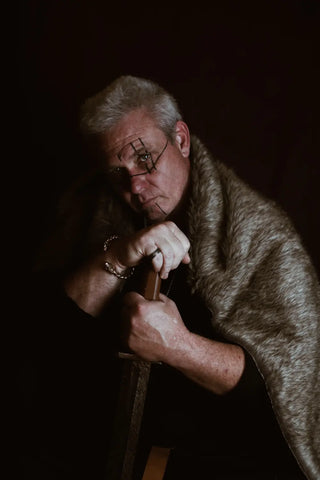Your Cart is Empty
Menu
-
- Shop by Type
- End of Line Sale Items
- New In
- Viking Gifts Under $30
- Hand Forged Axes
- Silver Viking Jewelry
- Stainless Steel Jewelry
- Cremation Jewelry
- Necklaces and Pendants
- Hand Carved Wooden Pendants
- Kings Chains
- Viking Drinking Horns
- Pendant Chains
- Rings
- Bracelets
- Earrings
- Beard Beads and Beard Rings
- Collectables
- Ceramic Mugs
- Street Wear
- Horn Jewelry
- Bronze and Pewter Jewelry
- Shop by Theme
- Viking Axe
- Celtic Jewelry
- Dragon or Serpent
- Viking Raven
- Wolf / Fenrir
- Rune Jewelry
- Odin Jewelry
- Ram / Goat
- Shieldmaidens / Lagertha
- Sword, Spear or Arrow
- Thor's Hammer / Mjolnir
- Tree of Life / Yggdrasil
- Helm of Awe / Aegishjalmur
- Triquetra or Triskelion
- Valknut / Knot of Slain
- Vegvisir / Viking Compass
- Veles / Bear
- Blogs
- Help
-
- Login

The Intricate Artistry Of Viking Jewelry: A Deep Dive Into Norse Craftsmanship

For centuries, Nordic Vikings commanded armies and sailed the seas, developing a fierce reputation for bloodshed and savagery. However, they were far more than just their ferocious fighting skills – a huge amount of Nordic culture and art stems from a deep creativity that transcends time and language. That’s why, in this guide, we’ll be exploring one of the Vikings’ many talents, jewelry-making, and how Norse craftsmanship has made its way into the modern age.
Vikings, Wearing Jewelry?
When you think of the Vikings, you probably think of their valiant battles or cruel punishments, and for good reason. The Vikings were a brave, seafaring people who lived in the Scandinavian region from the late 8th to the mid-11th centuries. Known for their unforgiving raiding, they travelled far and wide, from Iceland to Constantinople, spurred on by the belief that if they died in battle they may arrive at Valhalla, the ‘hall of the fallen’ ruled by the Norse god Odin.
With their reputation for cruelty and a determination to fight to the death, it’s easy to see the Vikings simply as bloodthirsty warriors. But in fact, they were also highly skilled craftsmen who created beautiful and intricate art, such as jewelry crafted from a variety of materials like gold and silver.
The Vikings were exceptionally skilled at creating beautiful necklaces, brooches and earrings, and these pieces would often be found featuring designs inspired by nature or decorated with precious stones like garnets or amethysts. But what made Viking jewelry so special was the incredible attention to detail and the unique designs – traditional Viking crafting techniques like filigree, granulation, and repoussé were very advanced, and allowed for a high degree of intricacy.
- Filigree: This technique involved twisting delicate gold or silver wires into detailed patterns. Most effective on intricate designs, like the tendrils and leaves that are prominent on Viking pieces, filigree was a popular technique that is still used by Nordic-style jewelers today.
- Granulation: By fusing small, granular beads of metal onto a surface, the Vikings could arrange them into unique patterns, and this tactic was one of the most popular among tribes who wanted to create beautiful rings.
- Repoussé: A lesser-used technique, but one that was just as effective, repoussé involved hammering metal from the back to create a raised design on the front. This technique was more commonly seen on arm rings, where a larger surface area was easier to work with, but it was also seen on smaller finger rings, too.
In addition to these techniques, the Vikings could also be found using punches and stamps to create patterns and inscriptions, particularly on rings, and occasionally they would use enamel to add color to their designs. Such designs would often have a symbolic meaning – many pieces were worn as a sign of status or as a symbol of loyalty to a particular leader or clan; arm rings were often given as a sign of loyalty, while necklaces and brooches were worn as a sign of wealth and status.
Iconic Imagery: The Viking Arm Ring
Even if you aren’t very familiar with traditional Viking jewelry, you may have seen an arm ring. One of the most famous types of Viking jewelry, these rings were worn around the upper arm and were given to warriors as a sign of loyalty or as a reward for bravery. Arm rings were typically made of silver, and some were decorated with intricate designs or inscriptions that depicted a person’s favorite god or the tribe to which he had sworn allegiance.
Because of the prominence of the Viking arm ring, it should come as no surprise that masses of these unique pieces have been found in hoards all over the world.
Famous Viking Jewelry Hoards
One of the most famous collections of Viking jewelry ever discovered is the Hiddensee treasure. Found on the German island of Hiddensee in 1873, this mind-blowing collection is believed to date all the way back to the 10th century! The treasure consists of gold necklaces, arm rings, and brooches, all of which feature intricate filigree designs and inscriptions.
Another well-known collection is the Cuerdale hoard, which was discovered in Lancashire, England in 1840. This hoard consists of over 8,000 items, including coins, silver ingots and jewelry – the jewelry in this hoard features intricate designs and inscriptions, including one brooch that is inscribed with a name. Although just a snapshot into the lives of the Vikings, these pieces highlight the true nature of jewelry in the time of the Vikings, and the importance that individuals placed on the pieces they treasured.
Viking Jewelry In A Modern World
Thanks to our deep understanding of the cultural and historical significance of Viking jewelry, modern technology has allowed us to replicate these beautiful works of art, even in the age of digital media and fast fashion – nestled in corners all around the world are Norse jewelry enthusiasts who come together over a shared love of the great Vikings who walked before us, and the jewelry that adorned their bodies.
Here at Norse Spirit, we specialize in bringing Viking jewelry to those who share our passion, and we’ve developed our collections to reflect the significance of these pieces to the Vikings of years ago, but also to how people wear them today.
Necklaces: Viking necklaces, such as the popular Mjolnir (Thor's Hammer) pendant or Valknut (knot of slain) pendant, can be worn as a statement piece on a simple chain. Today, they can be paired with casual or dressy outfits and can add a touch of edginess to any look.
Bracelets: Viking-inspired bracelets can be worn alone, or stacked with other bracelets for an effortless layered look. Whether you’re choosing a bracelet that aligns with your Nordic heritage, or you just want a bracelet that looks great with other metalwork, you can rely on the Vikings to have led the way.
Rings: Viking-style rings with intricate knotwork or animal motifs are a popular choice for both men and women. They can be worn alone, or stacked with other rings for a bolder look.

Viking jewelry can be incorporated into any modern outfit to add a touch of history and culture to the wearer's style, but there’s more to it than that – by incorporating Viking jewelry into your wardrobe, you can embody the brave warriors who came before you, and truly channel your inner Viking spirit.
